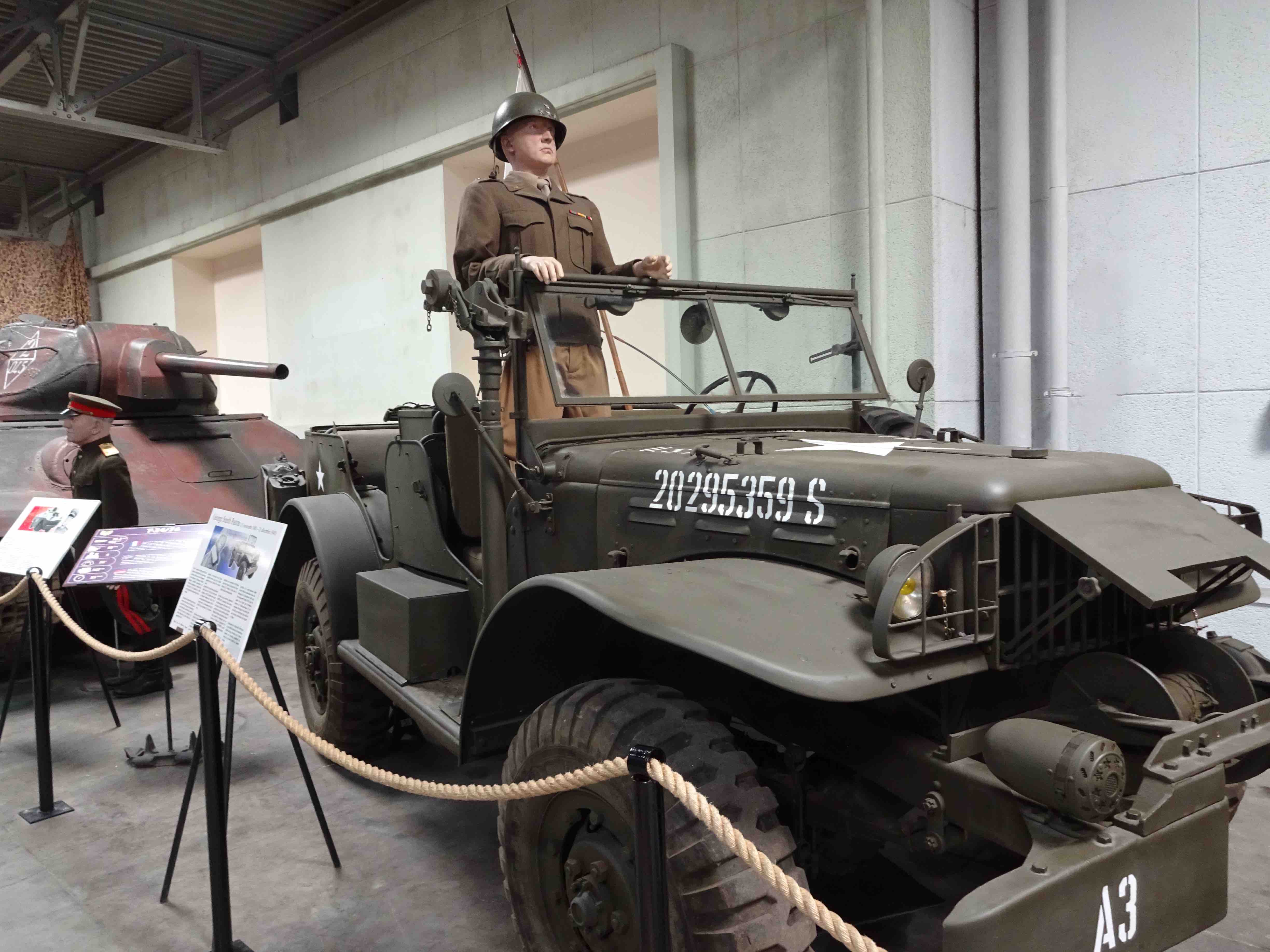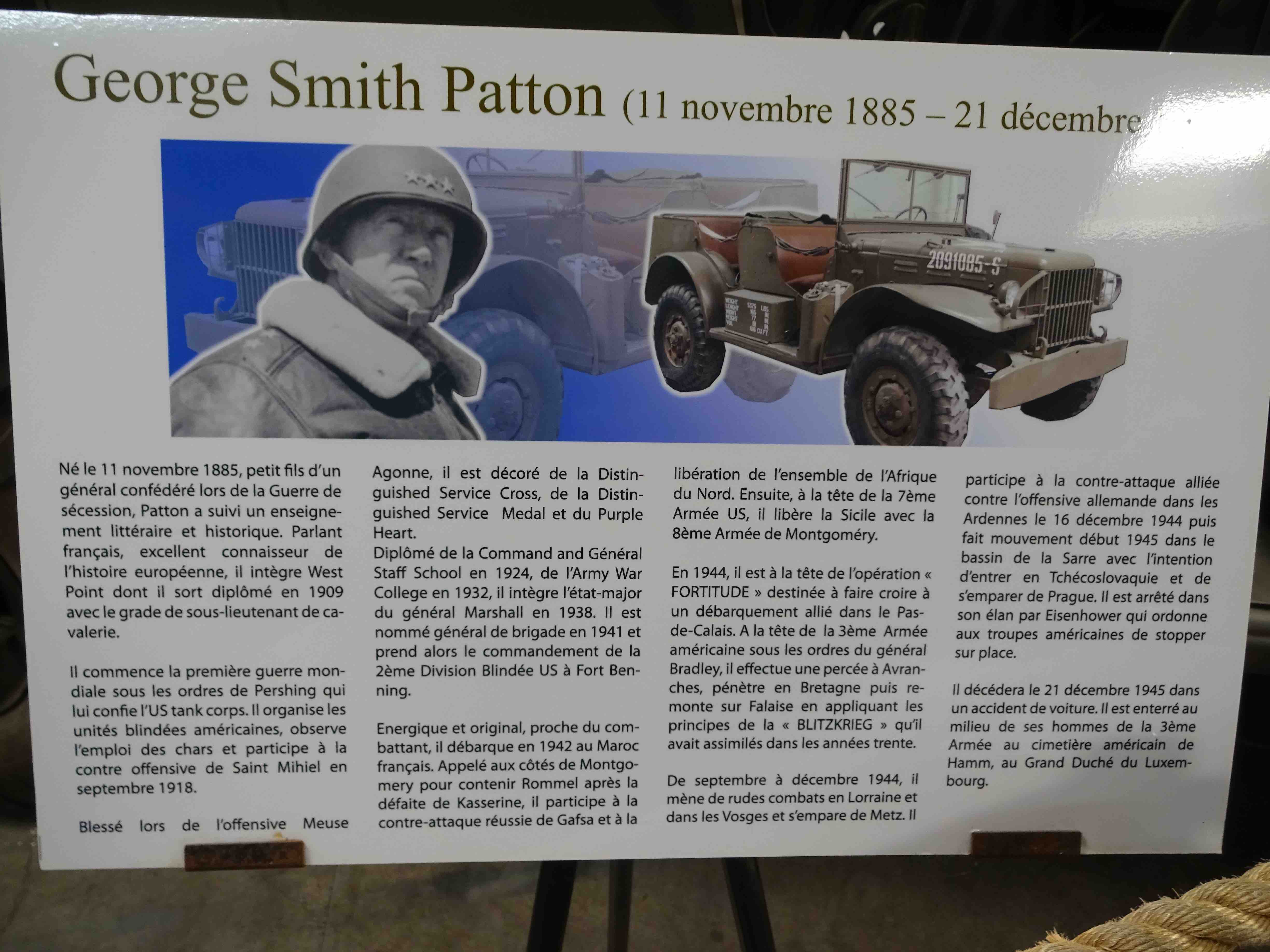George Patton Statue
Details:
The Patton statue is located in the room called "Les Alliés Seconde Guerre mondiale" (The Allies during the Second World War) in the back of the museum. Statue George Smith Patton was a native of San Gabriel, California, and is one of the most iconic figures in United States military history despite his boldness, in both character and dress, and sometimes outward hostility toward what he perceived as weakness; he even earned the nickname "Old Blood and Guts" due to his intensity.
Monument Text:
“Né le 11 novembre 1885, petit fils d’un général confédéré lors de la guerre de sécession, Patton a suivi un enseignement littéraire et historique. Parlant français, excellent connaisseur de l’histoire européenne, il intègre West Point dont il sort diplômé en 1919 avec le grade de sous-lieutenant de cavalerie.
Il commence la première guerre mondiale sous les ordres de Pershing qui lui confie l’US tank corps. Il organise les unités blindées américaines, observe l’emploie des chars et participe à la contre offensive de Saint Mihiel en septembre 1918.
Blessé lors de l’offensive Meuse Argonne, il est décoré de la Distinguished Service Cross, de la Distinguished Service Medal, et du Purple Heart.
Diplômé de la Command and Général Staff School en 1924, de l’Army War College en 1932, il intègre l’état-major du général Marshall en 1938. Il est nommé général de brigade en 1941 et prend alors le commandement de la 2ème Division Blindée US à Fort Benning.
Energique et original, proche du combattant, il débarque en 1942 au Maroc français. Appelé aux côtés de Montgomery pour contenir Rommel après la défaite de Kasserine, il participe à la contre-attaque réussie de Gafsa et à la libération de l’ensemble de l’Afrique du Nord. Ensuite, à la tête de la 7ème Armée US, il libère Sicile avec la 8ème Armée de Montgomery.
En 1944, il est à la tête de l’opération « FORTITUDE » destinée à faire croire à un débarquement allié dans le Pas-de-Calais. A la tête de la 3ème Armée américaine sous les ordres du général Bradley, il effectue une percée à Avranches, pénètre en Bretagne puis remonte sur Falaise en appliquant les principes de la « Blitzkrieg » qu’il avait assimilés dans les années trente.
De septembre à décembre 1944, il mène des rudes combats en Lorraine et dans les Vosges et s’empare de Metz. Il participe à la contre-attaque alliée contre l’offensive allemande dans les Ardennes le 16 décembre 1944 puis fait mouvement début 1945 dans le bassin de la Sarre avec l’intention d’entrer en Tchécoslovaquie et de s’emparer de Prague. Il est arrêté dans son élan par Eisenhower qui ordonne aux troupes américains de stopper sur place.
Il décédera le 21 décembre 1945 dans un accident de voiture. Il est enterré au milieu de ses hommes de la 3ème Armée au cimetière américain de Hamm, au Grand Duché du Luxembourg. »
English Translation:
“Born on November 11, 1885, as the grandson of a Confederate General from the American Civil War, Patton pursued a literature and history during his education. As a French speaker and connoisseur of European history, he entered West Point and graduated as a second-lieutenant in the cavalry in 1919.
He began his career during the First World War under the command of Pershing who assigned him to lead the US Tank Corps. He organized the American armored units, oversaw the use of tanks, and participated in the Saint Mihiel counter-offensive of September 1918.
Wounded during the Meuse Argonne offensive, he was decorated with the Distinguished Service Cross, the Distinguished Service Medal, and the Purple Heart. After graduating from the Command and General Staff School in 1924 and the Army War College in 1932, he became a member of General Marshall’s general staff in 1938. He was named Brigadier General in 1941 and then took the command of the 2ndUS Armored Division at Fort Benning.
Energetic and original and familiar with combat, Patton deployed in French Morocco. Called to Montgomery’s side to contain Rommel after the defeat at Kasserine, he participated in the successful counterattack at Gafsa and in the liberation of the North Africa group. Afterward, as the head of the 7thUS Army, he liberated Sicily with Montgomery’s 8thArmy.
In 1944, he was the head of the operation “FORTITUDE” designed to give the impression of an Allied landing in Pas-de-Calais. As the head of the 3rdUS Army under the orders of General Bradley, Patton initiated a breakthrough at Avranches, entered Brittany and then overtook Falaise by applying the principles of “Blitzkrieg” which he had adopted during the 1930’s.
Between September and December 1940, Patton lead brutal combat in Lorraine and in the Vosges and seized Metz. He participated in the Allied counter-attack against the German offensive in the Ardennes on December 16, 1944 then made a movement toward the Saar Basin at the beginning of 1945 with the intention of entering Czechoslovakia and capturing Prague. His momentum was stopped, however, by Eisenhower who commanded the troops to halt their advance.
Patton died on December 21, 1945, in a car accident. He is interred amongst his men of the 3rdUS Army at the American cemetery in Hamm, in the Grand Duchy of Luxembourg.”


